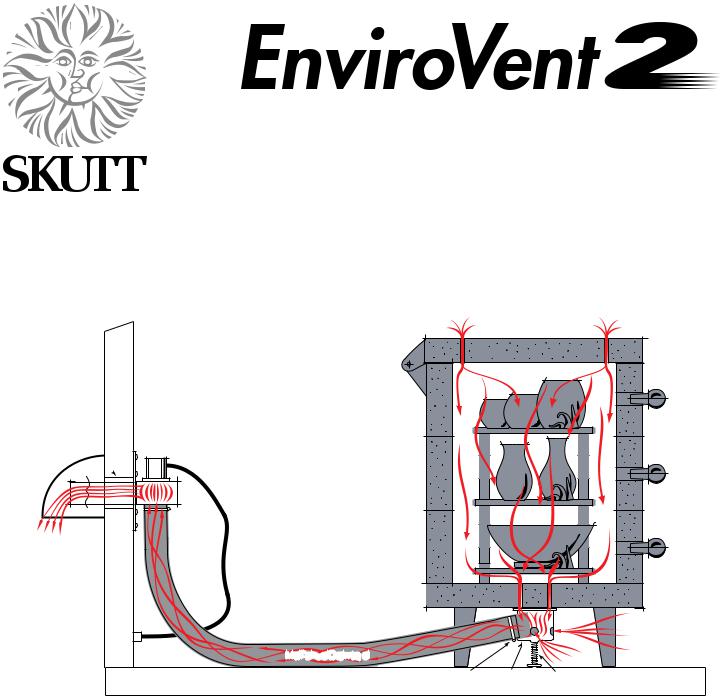Skutt EnviroVent 2 User Manual

NegativeMdf`shudOqdrrtqPressured
Operating Manual
6441 SE JOHNSON CREEK BLVD. PORTLAND, OR 97206 (503) 774--6000 SKUTT@SKUTT.COM
www.skutt.com |
Revised 7/07/15 |
|

2 |
Table of Contents |
|
Contents |
|
Introduction........................................................................... |
3 |
Setup...................................................................................... |
4 |
Standard EnviroVent 2 Installation....................................... |
4 |
Vent Hole Chart....................................................................... |
6 |
Dual Intake Kit......................................................................... |
9 |
Venting 2 Kilns.......................................................................... |
9 |
Custom Installations.............................................................. |
9 |
Venting Oval Kilns & Kilns Over 12 Cubic Feet.................. |
10 |
Additional Ducting Requirements.......................................... |
10 |
Using Central Ducting........................................................... |
11 |
Ceiling Mounting..................................................................... |
11 |
Side Mounting.......................................................................... |
11 |
Operation............................................................................... |
12 |
Troubleshooting..................................................................... |
13 |
Accessories............................................................................ |
14 |
Specifications......................................................................... |
15 |
2

Introduction 3
Congratulations
Congratulation on your purchase of the newly designed EnviroVent 2. The EnviroVent 2 is a Downdraft Ventila- tion System designed to extract fumes from your electric kiln and vent them outdoors before they have a chance to enter the room. Because it is a DownDraft Ventilation System the EnviroVent 2 also improves the firing atmo- sphere in the kiln while it is protecting you from the odorous fumes that can be emitted from certain clay bodies and glazes when they are fired. Here is what you get:
• |
True Downdraft Venting |
• |
Vent Up to 24 Cubic Foot Kiln • |
UL Listed Safe |
|
• Ability to Vent 2 Kilns |
• |
Corrosion Resistant Ducting |
• |
No Vibration to the Kiln |
|
• |
Spring Loaded Plenum Cup |
• |
Mounts Away From Heat |
• |
Potential to Control With Kiln |
How It Works
Adesignated number of holes are drilled in the lid and floor of the kiln either in the factory or on location. A spring loaded plenum cup (see diagram on page 4) is placed under the kiln and tensioned between the floor of the kiln and the floor under the kiln. The holes in the floor of the kiln are drilled in a tight pattern so the plenum cup can cover them all. The other end of the cup is connected by 3” ducting to a fan which is generally mounted on the wall. On the opposite end of the fan the air is ducted through the wall to the outside air.
The plenum cup has 3 additional holes from which it draws room temperature air to mix with the heated air from the kiln. This serves 2 purposes. Since the kiln air is mixed with cooler room air the air coming out of the end of the vent is never hotter than an average hair dryer. Secondly, the holes in the plenum cup are sized to reduce the vacuum on the kiln chamber so only a small amount of air is moving through the kiln. This ensures the firing time is not affected and the ware is not at risk.
Better Heat Uniformity
Most people are aware of the fact that heat rises. The EnviroVent 2 helps compensate for this rising heat by creating a flow of air moving back down the kiln chamber. As the air moves in a downward direction it is also deflected by ware and shelves causing turbulence. This turbulence helps move heat to cooler areas of the kiln.
Better Kiln Atmosphere
When you are firing in an electric kiln you are firing in an Oxidation atmosphere. The EnviroVent 2 helps bring in more oxygen and flush out fumes which can form a reduction atmosphere. Areduction atmosphere can be desir- able in a gas or wood fired kiln however it only causes problems in an electric kiln. Your elements will last longer, your glazes will be clearer and brighter and you will help prevent glazes migrating between pieces.
Better Working Environment
Prior to the introduction of venting systems it was still necessary to vent the kiln. This was done by propping the lid open with a wedge of brick until the kiln reached 1000 ˚F (538 ˚C). Not only was this inconvenient, it also radi- ated the fumes right into the room.
A Better Vent
Anew benefit of the EnviroVent 2 is that it is now a Negative Pressure System. This means that since the motor is pulling the air instead of pushing the air, if there is ever a hole in the ducting the fumes will not escape into the room. Also since the motor is now mounted away from the kiln it is protected from the heat of the kiln and the kiln is protected from possible vibration from the motor.
Aunique feature that no other vent on the market has is that the plenum cup is spring loaded. The floor of your kiln will have a tendency to cup when it heats up. This cupping can compromise the seal and reduce the pull of air on other models. With the EnviroVent 2 the Spring Loaded3 Plenum Cup ensures a tight seal throughout the entire firing.

|
|
|
4 |
Setup |
|
Standard EnviroVent 2 Installation
This section of the manual covers standard installations of The EnviroVent 2 on a single top loading, multi-sided, electric kiln with a chamber size under 12 cubic feet. ADual Intake Kit is available for venting a single kiln over 12 cubic feet or two kilns with chamber volumes each at or under 12 cubic feet. The maximum chamber volume that can be vented with one motor is 24 cubic feet. For instructions on venting two kilns, kilns greater than 12 cubic feet and other custom installations consult the Custom Installations section of this manual.
As with any change in firing routine, we recommend that you closely follow all instructions and monitor your fir- ings with witness cone groups on each shelf of your kiln both before and after you install the EnviroVent 2. If you have any questions, please contact your supplier.
EnviroVent 2 Contents
Blower Motor w/6 ft. Power Cord w/In-line Switch |
Floor Mount Plate |
|
8” x 12” Mounting Plate |
Operating Manual |
|
8 ft. x 3” FlexibleAluminum Duct |
Mounting Hardware |
|
Spring Loaded Plenum CupAssembly |
4 |
- #10 x 1 ½” Sheet Metal Screws |
Cast Plenum Cup |
4 |
- 8-32 x ¼” Screws |
Fiber Gasket |
4 |
- 8-32 Lock Washers |
Plenum Stand w/Base |
4 |
- 8-32 Hex Nuts |
Plenum Spring |
4 |
- 1/8” x 2” Toggle Bolts |
Blower Inlet Tube |
1 |
- 1/4” twist drill |
Blower Discharge Tube |
1 |
- 3/16” twist drill |
3” to 4” Connector |
2 |
- Hose Clamps |
|
|
Envirovent 2 |
|
|
|
Typical Installation |
|
|
Blower |
|
|
|
W/Motor |
|
|
|
3 1/8" Cutout |
|
|
Cut as |
in Wall |
|
|
Necessary |
|
|
|
Rain |
|
|
|
Hood |
|
|
|
|
Hose |
115 volt |
|
|
Cordset |
|
|
|
Clamp |
w/Switch |
|
3" x 8" Discharge Tube |
|
|
|
|
|
3" Diameter |
|
|
|
Flex |
Plenum |
|
|
Tube |
|
|
|
|
Cup |
|
|
|
Cup Stand |
|
|
|
With Spring |
|
|
|
Hose |
|
|
|
Clamp |
|
|
4 |
|

|
Setup |
5 |
Step 1 - Preparation
•Unplug the kiln
•At the time of purchase it is possible to order the kiln factory drilled. If your kiln has already been drilled for the EnviroVent 2 by Skutt, you may skip to Step 6.
•Before drilling the holes in the kiln it will be necessary to empty all of the ware and shelving from the cham- ber.
•Nearly every Skutt kiln uses a 8” high stand. The EnviroVent 2 is designed to fit under this 8” stand. If your stand is lower you can either shim the legs until it is 8” off the ground or replace it with a correctly sized Skutt Stand. If your stand is higher than 8” you can shim the plenum cup up so the bottom of the base is 8” from the bottom of the kiln or replace the stand with one with 8” clearance.
•If your kiln has been previously drilled for an EnviroVent or any vent other than an EnviroVent 2, it will be necessary to patch the existing holes before drilling new ones. Failing to patch incorrect holes in the kiln floor could cause the vent not to perform as designed. It is usually not necessary to patch holes in the lid unless they are drilled further than an inch away from the kiln wall. The amount of air vented is regulated by the holes in the floor so additional holes in the lid will not affect performance but could affect your ability to test the vent. See the Testing section of this manual. If you find that you need to patch holes in the lid follow the instructions below.
Patching Existing Holes
•Disassemble the kiln to allow full access to the kiln floor. (This will need to be done to remove an existing EnviroVent anyhow).
•Cover one end of the openings to existing holes with tape.
•Use Skutt Sairset (part# 0290) to fill the holes through the uncovered opening. Use a paper clip or element pin to help fill the hole. When you can’t get any more in the hole use a spackling knife to clean up the excess cement.
•Turn the kiln floor over, remove the tape, and fill any voids with Sairset.
•Re-assemble the kiln and allow the patch to dry for 1 hour before turning on the vent.
Step 2 - Determining The Number, Size and Location of Vent Holes
Use the Vent Hole Chart and Location Diagrams to determine the number, size and location of the holes for your particular kiln. The chart and diagrams are based on standard multi-sided top loading electric kilns greater than 1 cubic feet in size. If you are planning on venting a kiln smaller than 1.1 cubic feet please contact Skutt for hole drilling instructions.
The Vent Hole Chart refers to the number of “sides” a kiln has to determine the chamber width. This number refers to the number of brick used to form the circumference in a round or oval shaped kiln. This measurement is fairly standard between brands. Some kilns with 3” brick have smaller diameters but will not change the number or size of the holes drilled.
Kilns that are square or rectangular with multiple bricks per side will not fit this rule. For these kilns find out the total cubic feet of the kiln and use the closest value in the chart.
5
